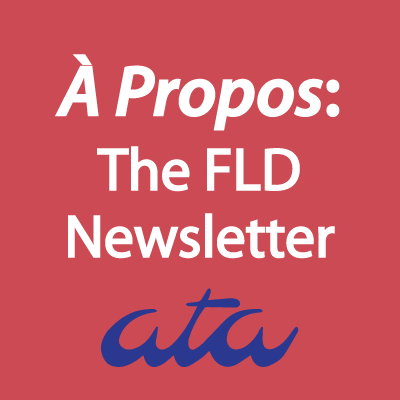When I tell other translators what language pairs I work in, I inevitably get one of several reactions: wow, those are so different! That’s impressive, where did you learn that second one? How the heck did you pick those two up? They’re nothing alike! Which language is that pink dot on your ATA badge?
My two working languages are French and Chinese (Mandarin). When I moved to Montreal for university, I decided that in addition to jumping into French translation, I would start taking another language as well. Portuguese, a language I was drawn to at the time, wasn’t offered, but I could choose from all of the official UN languages and others, including Hebrew and even Tibetan. At 8:00 a.m. on the first Monday of my first week, I attended my first Chinese class. The rest, as they say, is history.
Working with two very different languages presents a number of challenges and rewards. Below are just a few of them.
Challenges
- The “mental gymnastics” of translation
An article in the November/December 2017 issue of The Chronicle by Roz Schwartz includes the following quote from Nicky Harman, a Chinese to English translator:
“I’ve no evidence for this since I only translate from Chinese, but I think that languages that are very different from English are harder to translate because you have to do more mental gymnastics to get an acceptable English version. Not even the simplest sentence can be translated ‘literally’ (yes, I know that word opens another can of worms!).”
While my observations are also purely anecdotal, I would agree that working from Chinese to English is much more challenging and requires significantly more time and effort than working from French to English. English has borrowed extensively from French and, by virtue of the fact that both are Indo-European languages, they share many more similarities than do English and Chinese. The increased difficulty of Chinese affects all aspects of a translation project, from quoting to the translation itself to quality control, adding an additional layer of complexity and difficulty.
- Differences in prospecting tactics
The francophone world and the United States have relatively similar business practices. Marketing usually involves demonstrating your value to a potential customer and the customer deciding whether or not to buy based on a variety of factors, from price to perceived quality to simple convenience. China, on the other hand, has an additional level of complexity. Many people have heard of guanxi, a Chinese term that literally means “relationship” but encompasses the myriad personal connections that lubricate business dealings in China. This often means getting to know your client or counterpart on a personal level over multiple meetings, meals, and drinks. For a US-based freelancer, developing such relationships in China is very challenging. Therefore, in my experience, Chinese-to-English freelancers in the US generally work with US-based companies that are communicating with China, whereas French-English translators are able to work more easily with clients all over the world.
- The world’s most challenging writing system
Chinese is widely touted as one of the most difficult languages to learn. Tones completely aside, the writing system rivals all others in terms of difficulty and complexity (you may be seeing a common theme here: difficulty and complexity!). According to the BBC, there are over 50,000 distinct Chinese characters (thankfully only about 20,000 of which are still in use and listed in modern dictionaries). A university-educated Chinese person will know approximately 8,000 characters and to read a newspaper (and be a decent translator), you need to know upwards of 3,000 of them. Since there is no link between a way a character is written and how it is pronounced, Chinese is one of the only languages where you can see the words on the page, know what they mean, but not remember how to pronounce them; or conversely, know how to say a word but forget what it looks like. These complexities, coupled with the stark differences between English and Chinese, mean that I consult my dictionary far more frequently for Chinese than I do for French.
Benefits
- Broad cultural and linguistic reach
With English, French, and Mandarin combined, I can understand and facilitate communication between nearly 1.5 billion people. That’s almost a quarter of the people living on the planet! I get to experience an inspiring amount of cultural richness in what I am lucky to translate on a daily basis. In a single day, I can “travel” from Mainland China to Quebec City to Geneva to Kinshasa and back again.
- Lack of grammatical similarities or cognates
French and Chinese have almost nothing in common. French is relatively highly inflected; Mandarin has zero inflection. French grammar is derived from Latin whereas Chinese is a Sino-Tibetan language. This makes it all but impossible to confuse them or mix them up. Other than English loan words in Chinese, such as caffeine (kāfēiyīn, 咖啡因), pizza (pīsà, 披萨), salad (shālà, 沙拉), and others, including many place names, there are no cognates and therefore no need to keep a watchful eye on faux amis. When working in Chinese, I do not have to worry about getting tripped up by éventuellement, excité, or luxurieux.
- Daily intellectual stimulation
I often have the privilege of working on Chinese and French texts in the same day. Working from just one language to another can be challenging enough, so having the chance to work from multiple languages a day is an excellent way to keep my synapses firing. I definitely earn myself a nice glass of wine at the end of a long day (and that wine is often un bon vin français).
If you work in two very different languages or have had similar experiences, tweet the FLD at @ATA_FLD and Ben at @Bentranslates.
Ben Karl, MBA, CT is a French and Mandarin to English translator based in Reno, Nevada who specializes in marketing, financial, and creative content. Visit his blog, Ben Translates, or connect with him on Twitter and LinkedIn.
